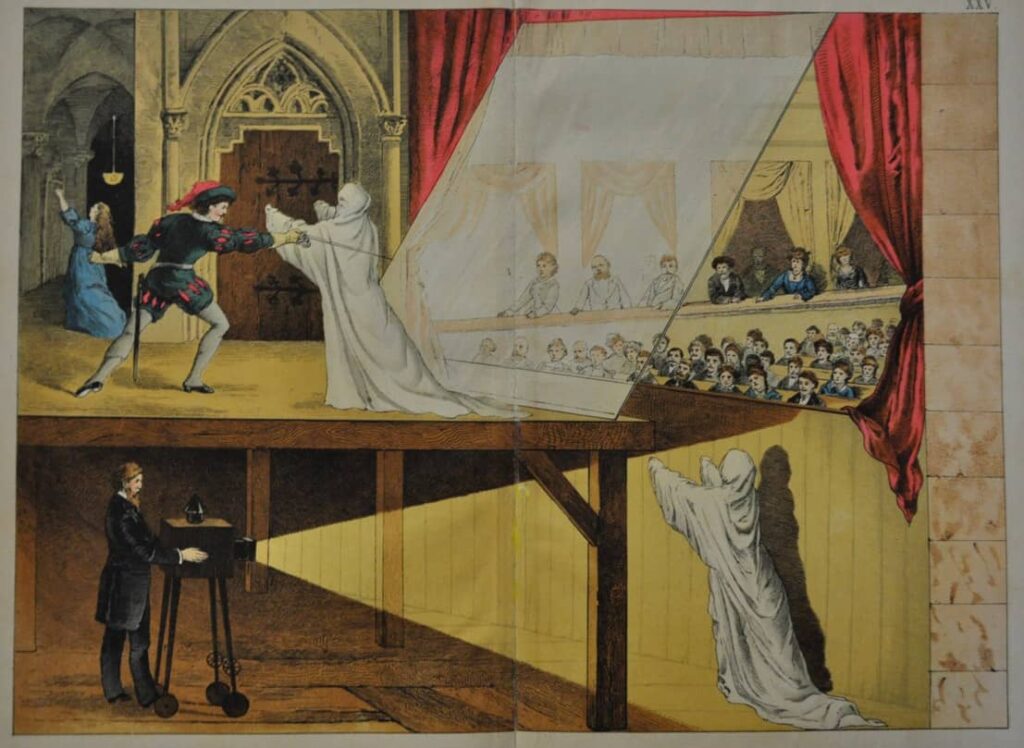Overview
What is the legendary Pepper’s Ghost effect?
Overview
What is the legendary Pepper’s Ghost effect?

Pepper’s Ghost – the innovation from the 18th century
When did Pepper develop the ghost effect?
In 1860, more than 150 years ago, the first holographic elements could already be shown on stage thanks to Pepper.
So let’s start at the very beginning. How is it possible that the first holograms could be shown in the middle of the century before last? Or rather, what technology was developed back then that still forms the basis for the new 3D holograms today?
What is the legendary Pepper’s Ghost effect?
Pepper’s Ghost is an illusion trick from the 19th century. Using the reflective properties of glass and later special plastic panes through to polyester films (depending on the desired area of application), objects are virtually projected into the air from a place invisible to the audience, under or to the side of the presentation surface, and thus appear in the viewer’s field of vision.
How does the Pepper’s Ghost effect work?
The principle of holography from 1860 is theoretically quite simple: using a flat glass, special lighting and taking into account the reflective behavior of the glass, the impression or optical illusion is created that objects or people appear and disappear. Of course, the technology at the time was rudimentary due to the weak light sources, such as oil lamps and candles, and the image that appeared was only faintly recognizable or very transparent. This is why mainly ghosts, spirits or other apparitions were shown, which also led to the naming of Pepper’s Ghost – after the inventor John Henry Pepper and his ghost technique.

Vergleich Peppers Ghost Effekt
Illustration - Pepper's Ghost past and present
High-performance projectors reproduce the 3D animated holograms via mirrors or by projecting them directly onto the glass panes – high-quality monitors are also used.
Modern 3D holography is only possible thanks to the immense progress in projector technology and high-performance computers that can create 3D animations.
>
Where is the Pepper’s Ghost effect used today?
Today, Pepper’s ghost effect is usedin 3D holographic pyramids, as eye-catchers at trade fairs, in museums, as stage holograms for music stars or for broadcasting press conferences.
If you have ideas about where you would like to use a hologram for your company – just ask us holography specialists, we will be happy to help.

Who was the legendary John Henry Pepper?
John Henry Pepper, also known as Professor Pepper, was born on June 17, 1821 in Westminster, London, where he lived until his death on March 25, 1900. Pepper was a British scientist who lectured from 1847 at the Royal Polytechnic Institution now the University of Westminster, and later became director of the university.
John Henry Pepper was legendary for bringing complex scientific topics and innovations to the public in a practical and easy-to-understand way through demonstrations and a good dose of entertainment.
Alongside his scientific work, he developed many new presentation techniques, using tricks from magic and sorcery and developing them further.
The technique under which Pepper is still famous today is the so-called Pepper’s Ghost effect – the basis for all modern-day holograms.
Other relevant articles
WACOM presents Bamboo Spark with hologram projector
WACOM presents Bamboo Spark with hologram projector Double innovation
Schmidt + Clemens relies on hologram technology
Schmidt + Clemens relies on hologram technology Eye-catcher at



